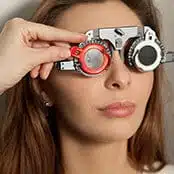
In short,
- Age-related macular degeneration (AMD) affects central vision.
- Early detection and management can slow AMD progression.
- Lifestyle changes and treatments can help preserve vision.
Age-related macular degeneration (AMD) is a common eye condition affecting central vision, impacting tasks like reading and driving. It damages the macula, the part of the retina responsible for sharp, central vision. Early detection and management are crucial for slowing its progression.
Understanding Age-Related Macular Degeneration
What is Macular Degeneration?
Macular degeneration targets the macula, the central part of the retina responsible for sharp, central vision. Damage to the macula affects focused vision.
- AMD is a progressive eye disease affecting the macula.
- AMD causes blurred or distorted central vision.
- There are two main types: dry and wet AMD.
Dry vs. Wet AMD
AMD has two forms: dry and wet. Dry AMD is more common and progresses slowly. Wet AMD is less common but more aggressive, potentially leading to rapid vision loss if untreated.
- Dry AMD: Characterized by drusen (yellow deposits) under the retina.
- Wet AMD: Abnormal blood vessels grow under the retina, leaking fluid and blood.
- Wet AMD can cause rapid vision loss if untreated.
Causes and Risk Factors for AMD
Genetic Predisposition
Genetics plays a role in AMD risk. A family history of AMD increases the likelihood of developing the condition. Specific genes have been linked to AMD. Genetic testing may be available to assess individual risk.
- Family history increases AMD risk.
- Genes in the complement pathway are linked to AMD.
- Genetic testing may assess individual risk.
Age and Ethnicity
Age is a major risk factor, with risk increasing significantly after age 60. Caucasians are more likely to develop AMD compared to other ethnic groups.
Lifestyle Factors
Smoking is a major modifiable risk factor for AMD. Obesity and a diet high in saturated fats may also contribute to the development or progression of AMD. Cardiovascular disease and high blood pressure are also associated with an increased risk.
Symptoms and Warning Signs of Age-Related Macular Degeneration
Symptoms
Symptoms of AMD can include blurred or distorted central vision, difficulty seeing in low light conditions, an increased need for brighter light when reading, a blurry or blind spot in central vision, the appearance of wavy lines, and difficulty recognizing faces.
Using the Amsler Grid
The Amsler grid is a tool used to monitor changes in central vision. To use it, cover one eye, focus on the center dot, and look for any distorted lines or missing areas. Report any changes to your eye doctor immediately.
- The Amsler grid monitors central vision.
- Check each eye for distorted lines or missing areas.
- Report changes to an eye doctor.
Diagnosis and Testing for AMD
Comprehensive Eye Exam
A comprehensive eye exam for AMD includes visual acuity testing, a dilated eye exam, and a careful assessment of the macula. The doctor will look for signs of drusen, pigment changes, and other abnormalities.
Optical Coherence Tomography (OCT)
Optical coherence tomography (OCT) provides detailed, cross-sectional images of the retina, helping identify fluid accumulation, retinal thickening, and other changes associated with AMD, particularly wet AMD.
- OCT provides detailed retinal images.
- It helps identify fluid accumulation and retinal thickening.
- OCT is essential for diagnosing and monitoring wet AMD.
Fluorescein Angiography
Fluorescein angiography visualizes the blood vessels in the retina. A dye is injected, and pictures are taken as the dye travels through the retinal blood vessels. This helps identify abnormal blood vessel growth in wet AMD and guide treatment decisions.
- Fluorescein angiography involves injecting a dye and taking pictures of retinal blood vessels.
- It helps identify abnormal blood vessel growth in wet AMD.
- This test is crucial for guiding treatment decisions.
Dry Macular Degeneration Treatment Options and Management
Lifestyle Modifications
Lifestyle modifications for managing dry AMD include quitting smoking, adopting a healthy diet rich in fruits, vegetables, and omega-3 fatty acids, maintaining a healthy weight, and controlling blood pressure.
AREDS2 Supplements
The Age-Related Eye Disease Study 2 (AREDS2) formula (vitamin C, vitamin E, lutein, zeaxanthin, zinc, and copper) may reduce the risk of AMD progression. Consult your doctor to determine if AREDS2 supplements are appropriate.
Low Vision Aids
Low vision aids, such as magnifying glasses and electronic magnifiers, can help improve vision and quality of life. Consult a low vision specialist to explore available options.
- Magnifying glasses and other low vision aids can help improve vision and quality of life.
- Electronic magnifiers can also be beneficial.
- Consult with a low vision specialist to explore available options.
Prevention and Lifestyle Changes for AMD
Protecting Your Eyes from UV Light
Protect your eyes from harmful ultraviolet (UV) light by wearing sunglasses that block 100% of UVA and UVB rays when outdoors.
- Wear sunglasses that block 100% of UVA and UVB rays when outdoors.
- UV light can damage the retina and increase the risk of AMD.
Diet and Nutrition
Consume a diet rich in antioxidants, such as lutein and zeaxanthin, found in leafy green vegetables. Include omega-3 fatty acids in your diet by eating fish and flaxseed. Limit your intake of saturated fats and processed foods.
Regular Eye Exams
- Schedule regular comprehensive eye exams, especially if you have risk factors for AMD.
- Early detection and management can significantly slow the progression of the disease.
When to Seek Professional Care for Age-Related Macular Degeneration in Washington, DC
Seek professional care if you experience any symptoms of AMD, such as blurred or distorted vision, difficulty seeing in low light, or a sudden change in your central vision. Sudden vision loss is an emergency and requires immediate medical attention. Early diagnosis and treatment can help preserve your vision.
When seeking treatment near me in Washington, call Advanced Sight Center at (636) 239-1650 or use our online appointment request form.




